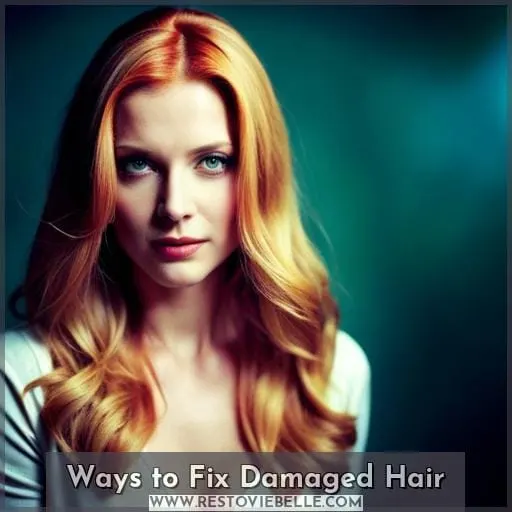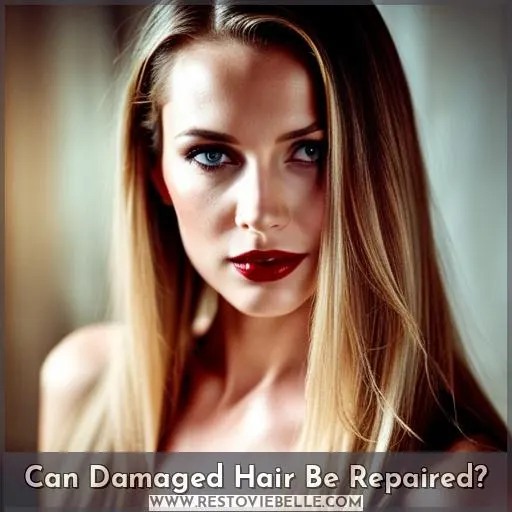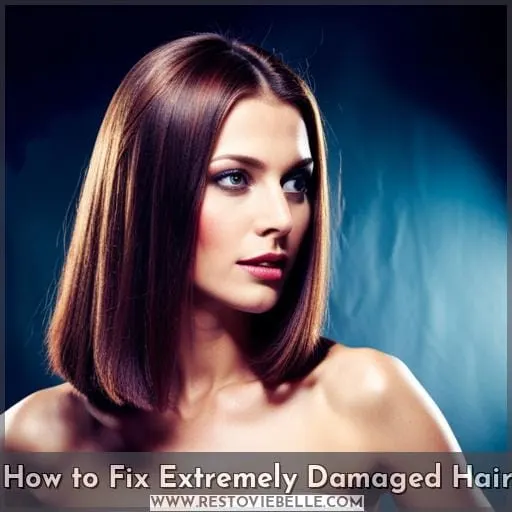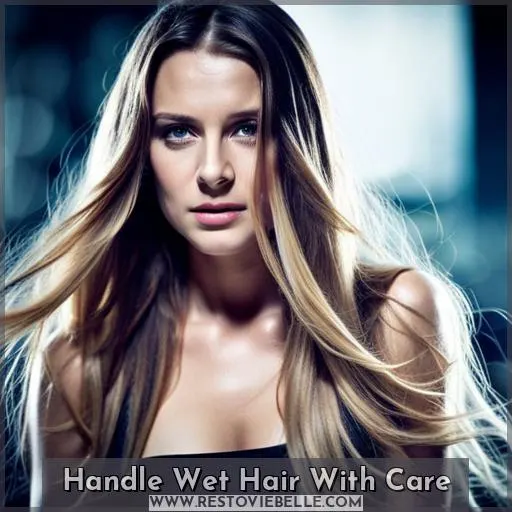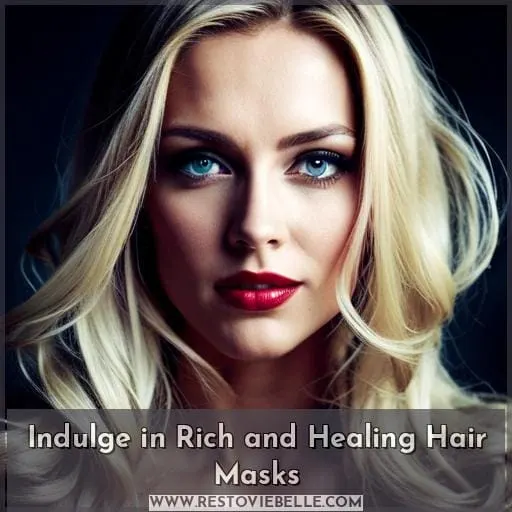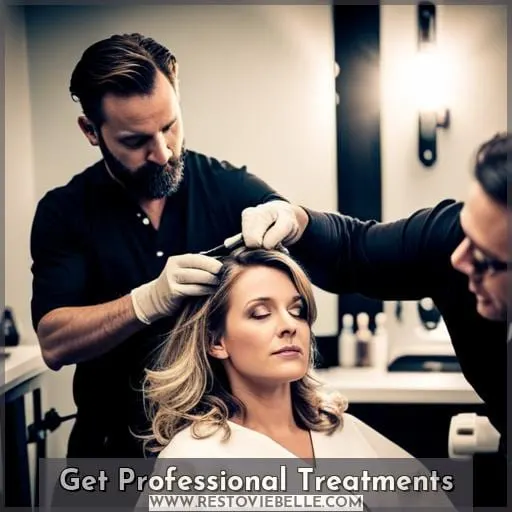This site is supported by our readers. We may earn a commission, at no cost to you, if you purchase through links.
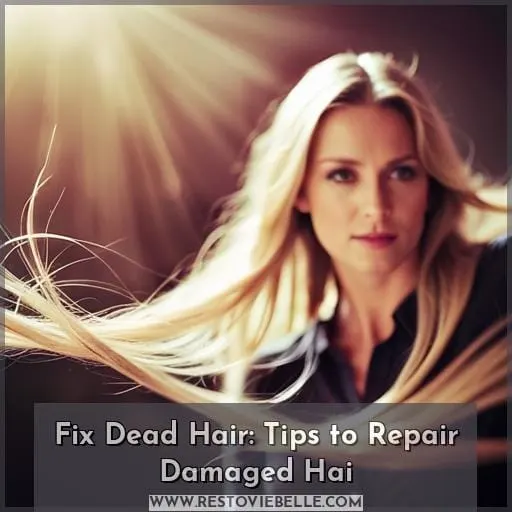 Imagine waking up to find your hair looking lifeless and dull, like a wilted flower. But fear not! There are ways to revive those dead strands and restore them to their former glory.
Imagine waking up to find your hair looking lifeless and dull, like a wilted flower. But fear not! There are ways to revive those dead strands and restore them to their former glory.
In this article, we will share expert tips on how you can repair damaged hair and bring it back to life. From using the right shampoo and conditioner for damaged hair to indulging in rich healing masks, get ready to give your locks the TLC they deserve.
Table Of Contents
- Key Takeaways
- Ways to Fix Damaged Hair
- Can Damaged Hair Be Repaired?
- How to Fix Extremely Damaged Hair
- Handle Wet Hair With Care
- Indulge in Rich and Healing Hair Masks
- Embrace Leave-Ins
- Get Professional Treatments
- Mind Your Bonds
- Trim Your Split Ends
- Swim and Sun With Care
- Frequently Asked Questions (FAQs)
- Conclusion
Key Takeaways
- Use UV protection sprays or wear hats for bleached hair.
- Lower heat styling tool temperatures and limit their use.
- Consult a professional hairstylist for safe bleaching.
- Incorporate deep conditioning treatments for hydration and restoration.
Ways to Fix Damaged Hair
If you’re struggling with damaged hair, there are several ways to fix it.
Blenched hair requires extra care and protection from UV damage, so consider using hats or UV protection sprays.
When it comes to heat styling, lower the temperature on your tools and limit their use whenever possible.
Additionally, choose a dye within three shades of your natural color and extend the time between dye jobs to prevent further damage.
Bleaching
To fix damaged hair caused by bleaching, you need to take steps to repair and nourish your strands.
- Use a professional hairstylist experienced in color treatments.
- Opt for gradual lightening techniques instead of aggressive bleach applications.
- Follow proper aftercare instructions provided by your stylist.
- Use color-safe shampoos and conditioners to maintain the vibrancy of your newly bleached hair.
- Regularly deep condition with olive oil or other hair treatment oils to restore moisture and prevent split ends.
Heat Styling
If you frequently use heat styling tools, such as flat irons or curling wands, there are several ways you can repair and minimize damage to your hair.
- Use lower temperature settings.
- Apply heat protection products before styling.
- Consider air drying your hair for a break from heat.
- Embrace beach waves and natural texture to prevent further damage.
Hair Color
If you’ve been struggling with damaged hair due to coloring, here are some effective ways to fix it:
- Protect your hair color by using color protection products and avoiding harsh chemical dyes.
- Maintain vibrant shades with regular touch-ups from a professional colorist.
- Nourish your hair with hydrating masks for optimal dye maintenance.
Can Damaged Hair Be Repaired?
You can repair damaged hair with the right care and treatment.
Damaged hair is a common problem that many people face, but there are steps you can take to restore its health and vitality.
Hair repair involves nourishing your strands from root to tip, providing them with the essential nutrients they need for recovery.
By incorporating effective hair care practices into your routine, such as using moisturizing products, avoiding excessive heat styling or chemical treatments, and regularly trimming split ends, you can gradually improve the condition of your damaged locks.
Remember that consistency is key when it comes to repairing damaged hair; be patient and diligent in following a proper regimen tailored for your specific needs.
With time and proper attention, you’ll witness remarkable progress in restoring your beautiful tresses back to their former glory.
How to Fix Extremely Damaged Hair
To fix extremely damaged hair, there are several key steps you can take.
Start by using a shampoo and conditioner specifically designed for damaged hair to nourish and repair your strands.
When washing your hair, opt for lukewarm water instead of hot water to prevent further damage.
Incorporate deep conditioning treatments into your routine to provide intense hydration and restoration.
Switch from a regular brush to a wide-tooth comb when detangling wet or dry hair, as this will minimize breakage.
Lastly, consider drying your hair with a t-shirt instead of rubbing it vigorously with a towel, as this gentler method helps preserve the integrity of the strands.
Use Shampoo and Conditioner for Damaged Hair
To address extremely damaged hair, start by incorporating:
- A shampoo and conditioner specifically designed for repairing and nourishing damaged strands.
- Consider color-safe options and leave-in conditioners for added protection.
Wash Your Hair in Lukewarm Water
Start by washing your hair in lukewarm water to repair extremely damaged strands.
Warm water helps open the hair cuticle, allowing it to absorb moisture and restore natural health.
Use a Deep Conditioning Treatment
To repair extremely damaged hair, incorporate a deep conditioning treatment into your hair care routine.
Deep conditioning is an intensive treatment that helps restore and nourish the hair for optimal recovery.
Using a nourishing mask or conditioner can help smooth the hair, improve its overall structure, and promote healthy growth.
Consider incorporating professional treatments or using high-quality products with ingredients specifically designed to repair damaged strands.
Remember to trim split ends regularly with professional shears and avoid harsh permanent treatments that can further damage your locks.
Switch Your Hairbrush for a Wide Tooth Comb
When repairing extremely damaged hair, take a step towards healthier strands by switching your traditional hairbrush to a wide tooth comb.
- Wide Tooth Comb: Gentle on tangled hair and prevents breakage
- Hair Detangling: Effortlessly removes knots and tangles without causing damage
- Hairbrush Alternatives: Provides an alternative option for those who prefer not to use brushes
- Tangle-Free Hair: Achieve smooth, manageable locks with minimal effort
Dry Your Hair With a T-Shirt
After switching your hairbrush for a wide tooth comb, the next step in fixing extremely damaged hair is to dry it with a t-shirt. This method helps minimize friction and damage caused by traditional towels while preserving moisture.
Handle Wet Hair With Care
When you have wet hair, handle it with care to prevent damage and breakage. Here are some tips for gentle wet hair care:
- Start by detangling your wet hair using a wide-tooth comb.
- Avoid rough towel drying and instead gently blot your hair with a microfiber cloth or soft t-shirt to minimize friction.
- Refrain from securing wet hair tightly with elastic bands as this can lead to breakage.
- Use brushes specifically designed for use on wet hair when necessary, as they’re gentler on the strands.
- Consider incorporating hydrating masks into your routine to moisturize effectively and repair damaged hair.
Remember that moisture is key in maintaining healthy locks. By following these hydration tips along with proper handling techniques, you can protect your fragile strands while also promoting their overall health.
Indulge in Rich and Healing Hair Masks
To further nourish and repair your damaged hair, it’s time to indulge in rich and healing hair masks that will provide deep hydration and restoration.
Deep conditioning is essential for repairing the damage caused by various factors such as heat styling, chemical treatments like dyeing or perming, and environmental stressors.
Hair masks are specially formulated with moisturizing treatments that penetrate deeply into the hair shaft to replenish moisture, strengthen strands, and improve overall hair health.
These masks offer a range of benefits including repairing split ends, reducing breakage, enhancing shine,and restoring elasticity.
To apply a hair mask effectively on your dyed or relaxed/straightened/permed locks,follow the instructions provided on the product packaging carefully.
Always remember to rinse thoroughly after leaving it on for the recommended duration.
With regular use of these nourishing treatments,you can fix dead hairend achieve healthier,happier tresses
Embrace Leave-Ins
To embrace leave-ins, start by incorporating these nourishing and protective hair products into your daily routine.
Leave-in conditioners offer a multitude of benefits for damaged hair. They provide deep hydration, help to detangle knots and prevent breakage, protect against heat styling damage, reduce frizz, and enhance the overall health and appearance of your locks.
There are various leave-in products available in the market that cater to different hair types and concerns. From lightweight sprays to creamy creams or oils infused with beneficial ingredients like keratin or argan oil – you can choose what works best for you.
Applying a leave-in conditioner is simple: after shampooing and conditioning your hair as usual, gently towel dry it before evenly distributing the product from roots to ends using either your fingers or a wide-tooth comb.
Avoid applying too much product as it may weigh down your strands; instead focus on targeting areas that need extra attention such as damaged ends or dry sections.
Get Professional Treatments
Now that you’ve embraced the power of leave-in treatments, it’s time to take your hair health to the next level with professional treatments.
Sometimes, DIY regimens may not be enough to fix extremely damaged hair. That’s when it becomes crucial to seek out the expertise and salon services offered by professionals in the industry.
Professional treatments are designed specifically for restoring and repairing damaged hair. They often contain high concentrations of active ingredients that can provide immediate transformation and nourishment for your locks.
Whether it’s a deep conditioning treatment, a revitalizing mask, or specialized techniques like hair bonding or trimming split ends – these professionals have mastered their craft through years of experience.
By investing in professional treatments, you’re giving your tresses an opportunity for intensive care they truly deserve.
Mind Your Bonds
Maintain the integrity of your hair by minding your bonds, ensuring they stay strong and healthy.
Repairing bonds is crucial for overall hair health and resilience. Your hair’s structure relies on these bonds to maintain its strength and elasticity, but daily styling, chemical treatments, and environmental factors can weaken them over time.
To protect your precious strands, invest in bond-building products that help reinforce these connections within the hair shaft. Look for ingredients like keratin or amino acids that specifically target bond protection and repair damaged areas from within.
By incorporating bond-repairing products into your routine regularly, you can fortify your locks against further damage while restoring their natural vitality and shine.
Keep those bonds strong to achieve luscious locks!
Trim Your Split Ends
- First, take a look at your hair and identify any split ends that need to be trimmed.
Split ends aren’t only unsightly but can also lead to further damage if left unattended.
When it comes to trimming advice, it’s best to leave this task in the hands of a professional hairstylist who’s the expertise and tools necessary for an effective trim. They’ll know exactly how much needs to be cut off while still maintaining the desired length of your hair.
Additionally, they may provide you with haircut tips that can help prevent future split ends from occurring.
By regularly trimming your split ends as part of your haircare maintenance routine, you’ll ensure healthier-looking locks and minimize breakage caused by damaged strands.
Swim and Sun With Care
When swimming or spending time in the sun, be mindful of how you care for your hair.
- Sun Protection:
- Just like we apply sunscreen to our skin, our hair also needs protection from harmful UV rays.
- Look for products with built-in UV filters or wear a hat when out in the sun.
- Swim Care:
- Chlorine and saltwater can wreak havoc on your hair, leaving it dry and brittle.
- Before taking a dip, wet your hair with fresh water to minimize chlorine absorption and use swim-specific shampoos afterward.
- Pool Hair & Beach Hair Solutions:
- To combat pool hair caused by chlorine buildup or beach hair due to saltwater residue, rinse thoroughly after swimming and follow up with hydrating conditioners or masks designed specifically for post-swim care.
Remember these tips next time you head outdoors so that you can enjoy all the fun without sacrificing healthy-looking locks!
Frequently Asked Questions (FAQs)
Can I fix dead hair without cutting it?
Yes, you can improve the condition of dead hair without cutting it.
Use moisturizing shampoos and conditioners.
Nourishing hair masks or treatments.
Protect from heat damage with lower temperatures and heat protection products.
What are some natural remedies for fixing dead hair?
To naturally revive dead hair, try a nourishing avocado and honey mask.
Mix mashed avocado with honey, apply to damp hair for 30 minutes, then rinse thoroughly.
This treatment will leave your locks as vibrant as a blooming garden in springtime.
How long does it take to repair dead hair?
Repairing dead hair can take time and patience. The duration depends on the extent of damage, your hair’s natural growth rate, and the effectiveness of your chosen treatments.
Can dead hair be revived or is it irreversible?
Yes, dead hair can be revived with proper care and treatment.
By using hydrating products, avoiding heat styling, and getting regular trims to remove damaged ends, you can help restore the health and vitality of your hair.
Are there any specific vitamins or supplements that can help fix dead hair?
To fix dead hair, it’s important to address the underlying causes and nourish your strands from within.
While specific vitamins or supplements may not directly revive dead hair, a balanced diet rich in essential nutrients can promote healthier hair growth.
Conclusion
To fix dead hair and bring it back to life, there are several steps you can take:
- Start by using shampoo and conditioner specifically designed for damaged hair.
- Wash your hair in lukewarm water to avoid further damage.
- Incorporate deep conditioning treatments.
- Switch to a wide tooth comb for gentle detangling.
- Embrace rich and healing hair masks, leave-in treatments, and professional treatments for extra nourishment.
- Remember to trim split ends regularly.
- Protect your hair from chlorine and sun damage.
With these tips, you can revive your damaged hair and restore its health and shine.
